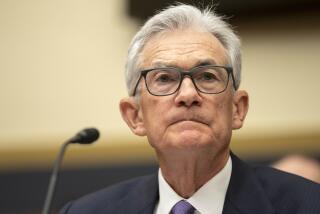Anna Schwartz dies at 96; economist, expert on monetary policy
Anna Schwartz, an economist and coauthor with Milton Friedman of a book on monetary policy that shaped the views of central bankers including Federal Reserve ChairmanBen S. Bernanke, has died. She was 96.
Schwartz died Thursday at her home in Manhattan after a long illness, said her daughter Naomi Pasachoff.
The first book that Schwartz wrote with Friedman, “A Monetary History of the United States, 1867-1960,” had “critical influence” on the outlook “of a generation of policymakers,” Bernanke said in 2003, when he was a Fed governor.
Published in 1963, the book advanced the idea that the Great Depression had been triggered by the central bank’s reduction in the U.S. money supply from 1928 until the early 1930s. That contradicted the prevailing view that it resulted from the 1929 stock market crash.
“Nobody knew as much about the history of monetary theory and the history of monetary policy in the United States as she did,” Philadelphia Fed President Charles Plosser said.
Schwartz wrote or edited nine books on monetary policy, including three with Friedman. Friedman won the Nobel Prize in 1976 for work that included his projects with Schwartz.
Plosser recalled that Friedman said his work with Schwartz was “a true collaboration.” Plosser, who served as co-chairman of the Shadow Open Market Committee with Schwartz, said that although “Milton gets a lot of the credit for it, I think Anna should share in that legacy.”
Schwartz’s name was not included in Friedman’s Nobel commendation.
“Anna was neglected in the citation,” said Edward Nelson, chief of the monetary studies section at the Fed inWashington, D.C., who interviewed Schwartz in 2003 for Macroeconomics Dynamics, an academic journal. Still, “the phrase ‘Friedman and Schwartz’ has become second nature in economics when discussing the importance of monetary policy.”
Schwartz, at a Cato Institute conference in November 2006 after Friedman’s death, said Friedman was “a great person to work with.”
“He could tell me I was wrong — ‘You have to rewrite,’” she recalled. “And I could tell him, ‘No, what you’ve written isn’t clear. You’ve got to go over it.’ It was that kind of exchange that made it possible for the ‘Monetary History’ to have such an extended life.”
Schwartz worked at the National Bureau of Economic Research into her 90s. She said in a 2003 interview she had no interest in retiring because “having something to think about is a much better life.”
In recent years, Schwartz emerged as an outspoken critic of efforts by the Fed and Treasury to revive credit and bail out companies during the financial crisis of 2008 and to combat the recession that lasted from December 2007 until June 2009. She called the 2008 rescue ofBear Stearns Cos.a “rogue operation” and an unwise widening of the government’s safety net.
“To me, it is an open and shut case,” she said in an interview in May 2008. “The Fed had no business intervening there.”
In a 2008 interview with Barron’s, Schwartz said the government needed to stop injecting liquidity into markets and reacting to the credit crisis with ad hoc programs.
“No one was more careful in analyzing monetary data and the inter-workings of the Fed and the Treasury than Anna Schwartz,” said John Taylor, an economics professor at Stanford University and a Treasury undersecretary under former President George W. Bush. “Her criticism of Fed actions when policy went off track, whether in the Great Depression of the 1930s or in the past few years, was always candid and has turned out to be correct.”
Anna Jacobson was born in New York City on Nov. 11, 1915, the third of five children of Jewish immigrants from Eastern Europe.
A 1934 graduate of Barnard College in New York at age 18, Schwartz earned a master’s degree when she was 19, and later a doctorate, from Columbia University. She began working at Bureau of Economic Research on a project on monetary data in the 1940s.
She met her husband, Isaac Schwartz, at a high school Hebrew camp. They were married from 1936 until his death in 1999. She is survived by their four children, as well as grandchildren and great-grandchildren.
More to Read
Start your day right
Sign up for Essential California for the L.A. Times biggest news, features and recommendations in your inbox six days a week.
You may occasionally receive promotional content from the Los Angeles Times.






